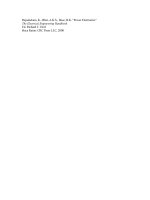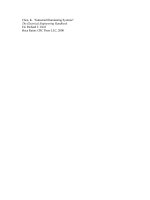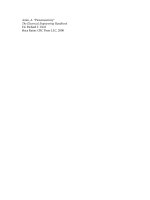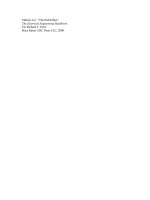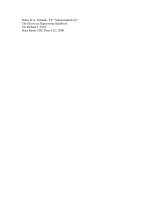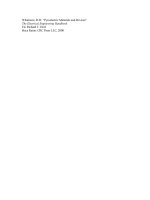Lecture Electrical Engineering: Lecture 14 - Dr. Nasim Zafar
Bạn đang xem bản rút gọn của tài liệu. Xem và tải ngay bản đầy đủ của tài liệu tại đây (738.3 KB, 32 trang )
COMSATS Institute of Information Technology
Virtual campus
Islamabad
Dr. Nasim Zafar
Electronics 1
EEE 231 – BS Electrical Engineering
Fall Semester – 2012
Bipolar Junction TransistorsBJTs
Lecture No:
14
Nasim Zafar.
2
References:
Ø Microelectronic Circuits:
Adel S. Sedra and Kenneth C. Smith.
Ø
Electronic Devices :
Thomas L. Floyd ( Prentice Hall ).
Ø
Integrated Electronics
Jacob Millman and Christos Halkias (McGrawHill).
Ø
Electronic Devices and Circuit Theory:
Robert Boylestad & Louis Nashelsky ( Prentice Hall ).
Nasim Zafar.
3
Reference:
Chapter 4 – Bipolar Junction Transistors:
Figures are redrawn (with some modifications) from
Electronic Devices
By
Thomas L. Floyd
Nasim Zafar.
4
Bipolar Junction Transistors
BJTsCircuits
C
B
E
Nasim Zafar.
5
Transistor Types
v
MOS Metal Oxide Semiconductor
v
FET Field Effect Transistor
v
BJT Bipolar Junction Transistor
Nasim Zafar.
6
◄
Transistor Current Characteristics
Nasim Zafar.
7
An Overview of Bipolar Transistors:
Ø
Ø
While control in a FET is due to an electric field.
Control in a bipolar transistor is generally considered to be due
to an electric current.
–
current into one terminal
determines the current
between two others
–
as with an FET, a
bipolar transistor
can be used as a
‘control device’
Nasim Zafar.
8
Transistor Biasing Configurations:
1.
CommonBase Configuration (CB) :
input = VEB & IE ; output = VCB & IC
2. CommonEmitter Configuration (CE):
input = VBE & IB ; output = VCE & IC
4.
CommonCollector Configuration (CC):
input = VBC & IB ; output = VEC & IE
Nasim Zafar.
9
Operation Modes:
Ø
Ø
Ø
Active:
–
Most importance mode, e.g. for amplifier operation.
–
The region where current curves are practically flat.
Saturation:
–
Barrier potential of the junctions cancel each other out
causing a virtual short.
–
Ideal transistor behaves like a closed switch.
Cutoff:
–
Current reduced to zero
–
Ideal transistor behaves like an open switch.
Nasim Zafar.
10
Operation Modes:
IC(mA)
Saturation Region
IB = 200 A
30
Active Region
IB = 150 A
22.5
IB = 100 A
15
IB = 50 A
7.5
Cutoff Region
IB = 0
0
0
5
10
15
Ø
Active: BJT acts like an amplifier (most common use).
Ø
Saturation: BJT acts like a short circuit.
Ø
Cutoff: BJT acts like an open circuit.
Nasim Zafar.
20
11
VCE (V)
Common Emitter Characteristics:
Ø
We consider DC behaviour and assume that we are
working in the normal linear amplifier regime with
the BE junction forward biased and the CB junction
reverse biased.
Nasim Zafar.
12
CommonEmitter Output Characteristics
IC
Output Characteristic Curves (Vc Ic
Active
Region
IB
Region of Description
Operation
Small base current
controls a large
collector current
Saturation VCE(sat) ~ 0.2V,
VC
E
Active
Saturation Region
VCE increases with IC
Cutoff
Achieved by reducing
IB to 0, Ideally, IC will
Nasim Zafar.
also equal 0.
Cutoff Region
IB = 0
13
CommonBaseConfiguration (CBC)
NPN Transistor
Circuit Diagram: NPN Transistor
Nasim Zafar.
14
CommonBase Output Characteristics:
Although the CommonBase configuration is not the most common
configuration, it is often helpful in understanding the operation of BJT
IC
mA
Output Characteristic Curves (Vc Ic
)
Breakdown Region
Saturation Region
6
0.8V
Active Region
IE
4
IE=2mA
2
Cutoff
IE = 0
IE=1mA
2V
4V
Nasim Zafar.
6V
8V
15
VC
B
Transistor Currents Output characteristics:
Nasim Zafar.
16
CommonCollector Output Characteristics:
EmitterCurrent Curves
IE
Active
Region
IB
VC
E
Saturation Region
Nasim Zafar.
Cutoff Region
IB = 0
17
Bipolar Transistor
Characteristics
•
21.4
Behaviour can be described by the current
gain, hfe or by the transconductance,
gm of the device
Nasim Zafar.
18
Conventional View & Current Components:
NPN TransistorCEC
Nasim Zafar.
19
Current Components:
NPN TransistorCEC
Nasim Zafar.
20
BJT Characteristics and Parameters
Nasim Zafar.
21
BJTCurrent Gain Parameters:
Ø
Two quantities of great
importance in the
characterization of
transistors are the so
called commonbase
Nasim Zafar.
22
BJTCurrent Gain Parameters:
Ø
Commonbase current gain , is also referred to as hFB and
is defined by:
= hFB = IC / IE
Ø
Commonemitter current gain β , is also referred as hFE and
is defined by:
Thus:
IC
= IC/IB
βIB
Nasim Zafar.
23
Beta ( ) or amplification factor:
Ø
Ø
The ratio of dc collector current (IC) to the dc base current
(IB) is dc beta ( dc ) which is dc current gain where IC and
IB are determined at a particular operating point, Qpoint
(quiescent point).
It’s define by the following equation:
30 < dc < 300 2N3904
Ø
On data sheet, dc=hFE with h is derived from ac hybrid
equivalent circuit. FE are derived from forwardcurrent
amplification and commonemitter configuration
respectively.
Nasim Zafar.
24
Ø
In the dc mode the level of IC and IE due to the
majority carriers are related by a quantity called alpha:
IC
=
IE
IC = IE + ICBO
Ø
It can then be summarize to IC = IE (ignore ICBO
due to small value)
IC
IE
Ø
For a.c situations where the point of operation moves on
the characteristics curve, an a.c alpha defined by
Nasim Zafar.
25
